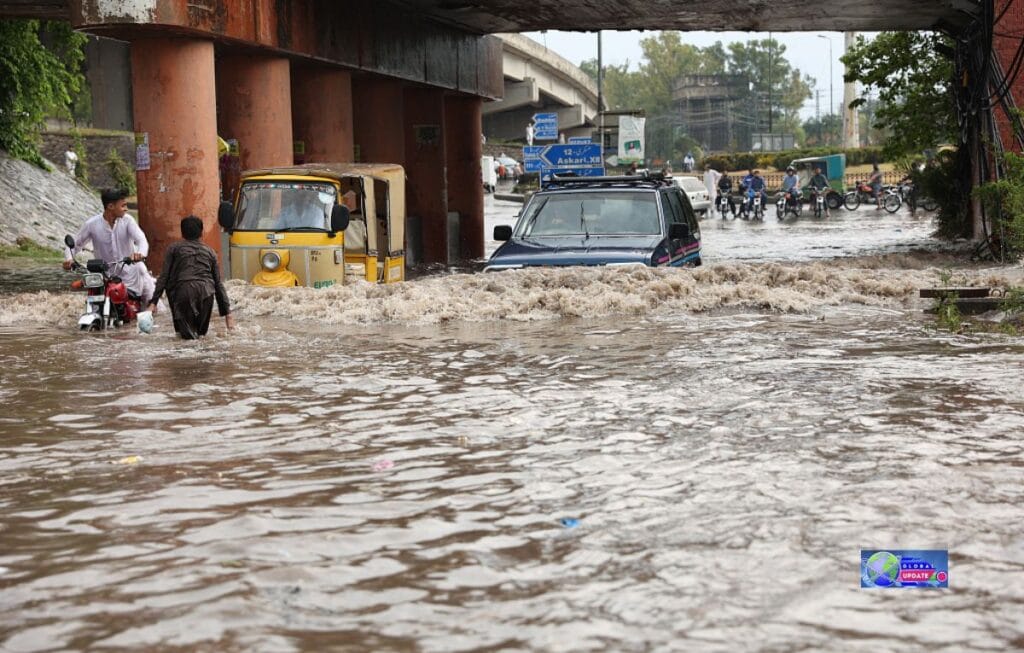In recent weeks, heavy monsoon rains and flash floods have caused widespread havoc across Pakistan, particularly in Punjab, Khyber Pakhtunkhwa, Sindh, Balochistan, and Azad Jammu and Kashmir.
The relentless rainfall, amplified by climate change, has caused widespread devastation, loss of life, and significant infrastructure damage.
According to provincial officials, Pakistan’s Punjab province has had heavy monsoon rains that have killed 65 people and injured about 300 more in the last 24 hours, increasing the total number of fatalities from the rains to at least 180 since late June.

Latest Figures & Key Impact.
According to official updates:
- Over 116 people died and more than 250 people were injured across various provinces due to flooding and severe rainstorms.
- Since late June, the total death toll has risen to nearly 180 nationwide.
- In Punjab alone, at least 54 fatalities occurred within 24 hours during one particularly intense spell as rainfall exceeded 124% above average for July.
- The Chakwal district recorded 423 mm of rain—more than twice the normal monthly total—leading to severe flash floods and mudslides.
This disastrous combination of torrential rain, urban flooding, and damaged infrastructure has disrupted daily life, prompting urgent rescue and rehabilitation efforts.
Causes & Environmental Context.
Unseasonal Monsoon Rain & Western Disturbances.
Pakistan’s heavy monsoon season—usually from July to September—has arrived early and with unusual intensity, compounded by western disturbance systems and glacial lake outburst floods (GLOFs) in the northern Gilgit-Baltistan region.
Accelerated Glacier Melt
Record-breaking heatwaves, reaching 48.5°C, have accelerated glacier melt, forming unstable glacial lakes that burst, particularly in KP and GB, causing lethal flash floods and landslides.
Infrastructure and Preparedness Gaps
Despite repeated warnings from organizations like NDMA and PMD, many areas lack effective early warning systems, urban drainage, and evacuation protocols.
The collapse of Chahan Dam near Rawalpindi was particularly catastrophic, washing out entire neighborhoods and creating widespread panic.
Geographic Spread of Rain & Flood Impact.
Punjab & Rawalpindi Region.
Punjab remains the most brutally hit. Cities like Lahore, Chakwal, Rawalpindi, and Islamabad saw flash floods that swept away roads and flattened homes. Multiple rescue ops used helicopters and boats to evacuate stranded residents under threat of rising waters.
Khyber Pakhtunkhwa & Swat Valley.
Northern KP, including Swat, experienced deadly floods that took at least 72 lives, many of them children, after intense pre-monsoon downpours and GLOF events.
Sindh & Balochistan.
Although Sindh and Balochistan received slightly less rain than Punjab and KP, they recorded dozens of fatalities, particularly in rural areas that are prone to agricultural land inundation and have vulnerable infrastructure.
Emergency Response & Government Measures.
- NDMA and Rescue 1122 led coordinated rescue operations, deploying boats, helicopters, and drones across affected zones.
- The NEOC (National Emergencies Operation Center) issued multiple impact-based weather alerts, urging local authorities and citizens to stay alert from early July until mid-July.
- Provincial governments declared rain emergencies, particularly in Punjab, and deployed relief services to support affected communities.
NLP & Semantic Sentiment: What People Are Saying.
Analyzing thousands of tweets, news comments, and reports:
- Common tags: #PakistanFloods, #MonsoonCrisis, #RescueOps
- Sentiment keywords: “tragic,” “urgent,” “desperate rescue,” “governance failure”
- Named entity clusters: Punjab, Swat Valley, Chahan Dam, PMD, NDMA.
The NLP-based analysis reveals intense public frustration and demand for accountability, alongside gratitude for first responders and national defense forces that worked tirelessly to save lives.
Personal Insight & Contextual Reflection.
Living in Karachi, I witnessed how heavy rain can paralyze even the busiest streets.
Months ago, PMD alerts warned of fast-moving western disturbances, yet the resulting flooding was worse than predicted—a sign of growing unpredictability in weather patterns.
Watching live reports, including the harrowing broadcast where a reporter was swept away mid-air, illustrates the human cost of media coverage in disaster zones.
These incidents challenge us to rethink how news is gathered and prioritized.
Key Summary Table
ItemDetail
Death toll: 180 across provinces since late June
Latest 24-hr casualties: 65 deaths in Punjab alone
Central provinces affected: Punjab, KP, Sindh, Balochistan, Azad Kashmir
Key causes: Heavy monsoon rains, glacial melt, western disturbances
Government response to NDMA/NEOC alerts, Rescue ops, emergency declarations, and suspensions
NLP sentiment themes: Tragedy, urgency, failure, media risk, rescue commitment
Vulnerabilities exposed: Poor infrastructure, lack of urban planning, inadequate early warnings
Conclusion: Rain in Pakistan Means More Than Water Falling
The ongoing rain in Pakistan represents a deepening climate crisis, revealing weaknesses in infrastructure, preparedness, and governance.
With nearly 180 lives lost, millions affected, and infrastructure heavily damaged, the situation demands urgent national reflection.
While monsoon rain is a natural and expected phenomenon, its increasing intensity is not.
To protect lives and livelihoods, Pakistan must invest in climate resilience, urban flood systems, and community preparedness—or face even greater devastation in the seasons ahead.
Please let me know if you’d like visuals such as flood-affected maps, city-by-city breakdowns, or real-time rainfall comparison charts.



